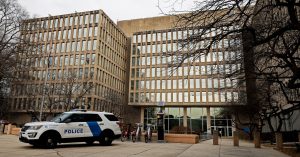There is a sense of apprehension over the National Institutes of Health
Scientists and the National Institutes of Health: Why are we so excited about what’s going on? Why do scientists worry about the future?
“Most scientists are very worried,” agrees Bruce Alberts, a professor emeritus of biochemistry and biophysics at the University of California, San Francisco, who served as the president of the National Academy of Sciences from 1993 to 2005. “They both have a record of ignoring the best science and making statements and opinions that are not based on the best science and more are based on emotion and the misreading of science.”
“I have grave concerns,” says Keith Yamamoto, special adviser to the chancellor for science policy and strategy at the University of California, San Francisco, who chairs the Coalition for Life Sciences, which advocates for U.S. health agencies. “People are dismayed about the chaos and confusion being sown and don’t really know what to do.”
“If this all lasts for a few more days or a couple weeks and then the reforms are lifted, we’ll evaluate them on their merit, that’s fine,” says the dean of the Brown University School of Public Health. “But, boy, at the moment it’s really disruptive and harmful.”
As President Trump takes the reins of the federal government, one of the agencies in turmoil is the National Institutes of Health — the world’s leading public funder of biomedical research.
Even the NIH’s biggest fans say the agency is far from perfect. The grant-review process has been under consideration for a while, one of which is making it more transparent. A sense of worry is being described by many scientists inside and outside of the NIH.
“It has been the period of most uncertainty in my adult and professional life as a scientist in terms of the continuity of projects,” Daniel Colon-Ramos, a professor of neuroscience at Yale School of Medicine. The general feeling is one of concern and uncertainty in the scientific community.
Officials at many institutions are worried about what might happen next. Kevin Wilson, vice president at the American Society for Cell Biology, said that he had heard that some extramural institutions were making anticipation holds on spending in case of another spending freeze.
There is uncertainty about whether grants are being processed and payments are being made, but so far, funding seems to still be flowing.
Out of the $48 billion annual budget of the National Institute of Health, roughly half goes towards funding researchers outside of the agency.
“It’s incredibly frustrating,” says Marjorie Levinstein, another postdoctoral fellow at NIH with the union. She studies addiction among other things and says she had to put aside a big step in her research. “It’s really harming our ability to make huge medical breakthroughs.”
But a hiring freeze at the NIH remains in place, along with a prohibition on starting any new research projects on NIH’s campus, and a pause on recruiting new patients for any clinical studies at the agency.
The communications black out has started to lift according to a statement released by the NIH. The NIH has restarted closed sessions of committees subject to the Federal Advisory Committee Act, which includes advisory councils and boards and scientific review groups.
Science is moving at high speeds. And requires that all of us in the scientific community work together,” Chatelaine said. “Any gap that we experience sets us back in terms of being able to conduct the cutting edge biomedical research that Americans need to stay healthy.”
Haley Chatelaine, a research fellow studying basic cellular functions at theNIH who helps bargain for the union representing 5,000 NIH fellows, says that it’s a huge deal. She was one of just a few NIH employees willing to speak on the record with NPR.
The new administration imposed a blackout on the NIH and other health agencies on most communications with the outside world and banned travel, forcing the cancellation of meetings needed for decisions about what research to fund next in the fights against cancer, heart disease, diabetes and other diseases.
One popular program implemented by USAID, however, has already been granted an “emergency humanitarian waiver” to keep operating: the President’s Emergency Plan for AIDS Relief, or PEPFAR.
WIRED interviewed eight current and former USAID employees and contractors for this story, several of whom directly work on the agency’s HIV and AIDS programs. They were granted anonymity due to fears of retaliation and because they were not authorized to speak publicly about the agency. USAID did not respond to requests for comment.
The Department of Government Efficiency (DO GE) service, headed by Elon Musk, has been busy since President Donald Trump took office. The agency has been gutted to the point that it has not been the same since. A group of young agents from the DOGE team arrived at the headquarters last week, and immediately began cutting off staff email accounts. A current USAID employee says that the situation has been horrible.
Musk said on social media Sunday that they had spent the weekend feeding USAID into the wood chipper. “Could [sic] gone to some great parties. Did that instead.”
“My money is being unfrozen but you can’t contact the people that actually froze it,” says a senior official at an HIV/AIDS organization
“Your money is being unfrozen but you can’t contact the people who actually froze it,” a senior official at an HIV/AIDS organization told WIRED. “There’s a bigger communication blockage that is frustrating even the efforts put in place to free up the lifesaving work.”
